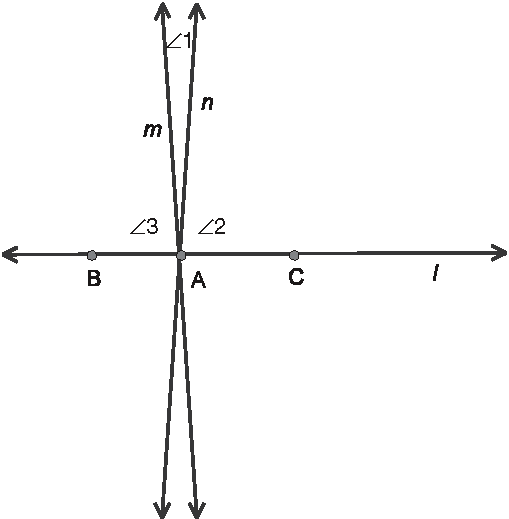Geometry: Proofs Involving Perpendicular Lines
Proofs Involving Perpendicular Lines
I'll begin with a review of what you've learned about lines. Whenever you have two lines, only one of three things can happen: Either they are the same line, they are parallel lines, or the two lines intersect at a point. If the two lines intersect at a point, the vertical angles formed are congruent. The intersecting lines either form a pair of acute angles and a pair of obtuse angles, or the intersecting lines form four right angles. When the lines meet to form four right angles, the lines are perpendicular.
The main fact to establish about perpendicular lines has to do with uniqueness. Remember that that the midpoint of a line segment and the angle bisector of an angle are unique. You learned that if you are given a point and a line, there is a unique line passing through that point that is perpendicular to the line. You now have the skills to establish the uniqueness property of perpendicular lines.
- Theorem 10.1: Given a point A on a line l, there exists a unique line m perpendicular to l which passes through A.
- Example 1: Write a formal proof for Theorem 10.1.
- Solution: Start with a game plan for how to approach the problem. Figure 10.1 shows a line l and a point A on l. You want to show that there is a unique line m perpendicular to l which passes through A. The way you proved uniqueness in earlier examples was to assume that there were two, and obtain a contradiction. That's the same approach to take here.

Figure 10.1A line l and a point A on l.
The drawing you will use for your proof needs two distinct lines, m and n, which both pass through A and are perpendicular to l. Figure 10.2 illustrates that situation. The contradiction you'll obtain involves the Protractor Postulate. Recall that when two lines are perpendicular, they meet to form right angles. Lines m and l form ∠3. Lines n and l form ∠2. Because m and n are distinct lines that meet at A, when they intersect they will form ∠1. Together ∠1, ∠2, and ∠3 form the straight angle ∠BAC, so the sum of their measures must be 180º. But if m∠2 = 90º and m∠3 = 90º, you have accounted for all of the 180º. There are no more degrees left over to form ∠1. That's where the problem lies: m∠1 = 0º , which contradicts the Protractor Postulate. Now that you have a game plan, you can write the formal proof. At this point you should be comfortable with the format of a formal proof, so I'll just go through the steps.

Figure 10.2Two distinct lines, m and n, which both pass through A and are perpendicular to l.
- Theorem 10.1: Given a point A on a line l, there exists a unique line m perpendicular to l which passes through A.
- The drawing is shown in Figure 10.2.
- Given a line l and a point A on l, suppose there are two lines, m and n, which both pass through A and are perpendicular to l.
- Prove that m∠1 = 0º
- Proof: As far as a game plan goes, I have already outlined most of the proof. You'll use the definition of a straight angle, the Angle Addition Postulate, and the Protractor Postulate.
| Statements | Reasons | |
|---|---|---|
| 1. | Points A, B, and C lie on a line l, and m and n are distinct lines which both pass through A and are perpendicular to l | Given |
| 2. | ∠BAC is a straight angle, and m∠BAC = 180º | Definition of straight angle |
| 3. | m∠1 + m∠2 + m∠3 = m∠BAC | Angle Addition Postulate |
| 4. | m∠1 + m∠2 + m∠3 = 180º | Substitution (steps 2 and 3) |
| 5. | ∠2 is a right angle | Definition of perpendicular ( n ⊥ 1 ) |
| 6. | ∠3 is a right angle | Definition of perpendicular ( m ⊥ 1 ) |
| 7. | m∠2 = 90º , m∠3 = 90º | Definition of right angle |
| 8. | m∠1 + 90º + 90º = 180º | Substitution (steps 4 and 7) |
| 9. | m∠1 = 0º | Algebra |
You have established your contradiction, and thus the assumption that there were two distinct lines perpendicular to l passing through A was false. Uniqueness is established.
Excerpted from The Complete Idiot's Guide to Geometry © 2004 by Denise Szecsei, Ph.D.. All rights reserved including the right of reproduction in whole or in part in any form. Used by arrangement with Alpha Books, a member of Penguin Group (USA) Inc.
To order this book direct from the publisher, visit the Penguin USA website or call 1-800-253-6476. You can also purchase this book at Amazon.com and Barnes & Noble.







